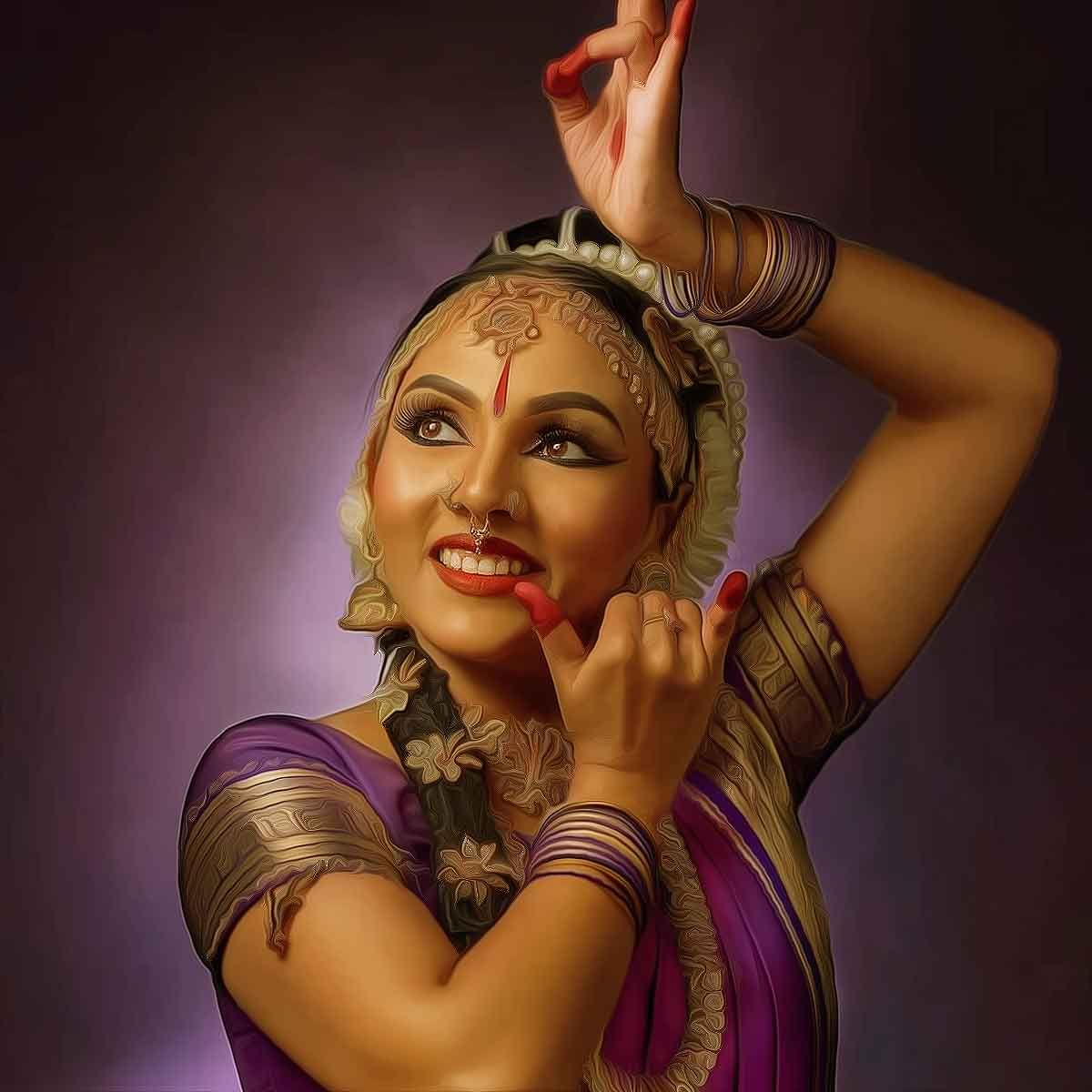More Coverage
Twitter Coverage
Satyaagrah
Written on
Satyaagrah
Written on
Satyaagrah
Written on
Satyaagrah
Written on
Satyaagrah
Written on
Join Satyaagrah Social Media
"Sringara Prakasa - Sanskrit poetry": Classical theater, dancers (Bharatanatyam, Odissi, Mohiniyattam) refer to Sringara as 'the Mother of all rasas, one of the nine rasas, usually translated as erotic love, romantic love, or as attraction or beauty

Sringara Prakasa (शृङ्गार प्रकाश – Śṛṅgāra Prakāśa) is a voluminous set of Sanskrit poetry consisting of thirty-six chapters, documented in 1908. It deals mostly with Alamkara-Shastra (rhetoric) and Rasa, and is claimed to have been authored by Raja Bhoja, the king of Paramara dynasty in the early 11th century A.D. A large extent of this magnum opus is dedicated to Sringara Rasa, which according to Bhoja's theory: "is the only one Rasa admissible.”
Sringara (Sanskrit: शृङ्गार, śṛṅgāra) is one of the nine rasas, usually translated as erotic love, romantic love, or as attraction or beauty. Rasa means "flavour", and the theory of rasa is the primary concept behind classical Indian arts including theatre, music, dance, poetry, and sculpture. Much of the content of traditional Indian arts revolves around the relationship between a man and a woman. The primary emotion thus generated is Sringara. The romantic relationship between lover and beloved is a metaphor for the relationship between the individual and the divine.
Classical theater/dancers (i.e. Bharatanatyam, Odissi, Mohiniyattam) refer to Sringara as 'the Mother of all rasas.' Sringara gives scope for a myriad of other emotions including jealousy, fear, anger, compassion, and of course for the expression of physical intimacy. No other Rasa has such a vast scope.
The treatment and performance of Sringara varies on a large scale from the grotesque (as in Koodiyattam) to very refined and subtle (as in some styles of Bharatanatyam, or in Odissi).
The attraction between lover and beloved is a metaphor for the relationship between the individual and the divine, the Nara-Narayana relationship. Natya Shastra lists Vishnu as the presiding deity of the Sringara rasa.
|
Only in India could a work of this kind remain unpublished for nearly a thousand years! Elsewhere writings are rushed to print before the ink is dry on the paper.
Maharaja Bhoja Deva was an erudite and enlightened sovereign of Malava in Central India over 9 centuries ago. Incidentally, it may be observed that Sanskrit is the only language in the world, in which the science of Poetics has been developed with microscopic perfection. The reason is perhaps that Sanskrit is the oldest, the longest, and the greatest of World literature, presenting a vast and variegated expanse for the literary star-gazer.
In that realm of literary science, Bhoja Dev has reached farther than any other thinker of ancient or modern times. Having dwelt over the subject in 'Saraswati-Kanthabharana' according to the accepted canons, he felt impelled to the conviction that, of all the rasas, Shringars, or Love, was the prominent rasa contributive to literary excellence. The late Mahamahopadhyay Professor S Kuppuswamy Sastriar of Madras observes, -
"Sringara Prakasa is a hitherto unpublished work of Alankara of an encyclopedic character. In this mammoth work King Bhoja endeavors to bring under literature and literary appreciation everything of importance in Indian thought as embodied in Sanskrit writings, both Shastraic and non-Shastraic, and the method which Bhoja's massive mind adopts for this purpose is the eclecticism of an all-comprehending type."
Translations
Though many scholars have attempted to translate this magnum opus of Raja Bhojadeva, Sheldon Pollock's and Dr. V Raghavan's works are considered as dominant interpretations. Pollock notes that in spite of the fact that the Sringara Prakasa is so relevant in the current time because of its content and its similarity with existing Sanskrit literature including its organization and style, it had not attracted much attention except in South India and Bengal. During the mid-20th century, there were claims of only four incomplete manuscripts available, out of which two were transcripts of a third one. But, V. Raghavan's translated commentary based on the fourth manuscript is considered valuable among scholars even today.
|
The Cantos
This work of Bhoja is different from his other, smaller works such as Sarasvatī-kaṇṭhabharaṇa. The name Sringara Prakasa bears significance as it attempts to deal with Sringara Rasa of Ahamkara and Abhimana. In chapter I, Bhoja talks about Rasa as the "greatest element by virtue", and thus, men are called Rasikas accordingly. This is invoked through Kavya drama and poetry. There, Bhoja refers to Bhamaha and attempts to unite the two by calling them "शब्दार्थो सहितौ काव्यम": Poetry is a word (Sabda) and sense (Artha) united. Most of the content in chapters I-VI deals with grammar, words, sense, and Sahitya. Chapters VII-VIII deal with the relationship between Sabda and Artha and define Sahitya by dividing it into Sabda and Artha. Chapter IX deals with poetical relations with Sahitya, whereas chapter X is primarily about different kinds of Alamkaras. In chapter XI, Bhoja calls his work "Sahitya-Prakasa" and gives more importance to Rasa by saying: "A poetry may be as much flawless by adopting Alamkara, but every poet should pay apt attention to the Rasa, as it is the greatest factor of beauty and in the absence of it, all other beauties are in vain." In chapter XII, Rasa, as well as the structure of drama are discussed. Chapter XIII classifies Ahamkara-Sringar into four: Dharma, Artha, Kama, and Moksa , and briefly describes the activities to be fulfilled to achieve the four purusharthas. The rest of this voluminous work deals with Rasas, the greatest Sahitya of Sabda and Artha in Kavya.
Hinduism is not only a religion but it is also a philosophy, not only a religion and philosophy, but it is a way of life. The Hindu shastras meaning scriptures show the correct way how to lead a successful life for every man and woman. There is a wrong notion that Hinduism hates Sexual intercourse and compels everybody to hate the art of sex.
Maharishi Vatsayana in his kama sutra (The art of Sex) describes everything about sex in a beautiful manner. According to the Hindu Shastras, women are of four types. Padmini (The Lotus girl), Chitrini (elegant girl), Sankhini (the tall girl), and Hastini (Elephant girl).
It is very rare to see a Padmini. Draupadi, Ahalya, Anusuya, Sita are all of Padmini type.
Similarly, we have types of men and poses in the art of Love.
The Hindu kings patronized poets in their courts. And these poets are well versed with the Kama Sastra (The Science of Sex) and used to compose love poems to please the king.
The people of the world should first read the Kama Sutra of Vatsayana before marriage.
King Bhoja maharaja has written many books. He is a very great Sanskrit scholar. He has been credited with works in every branch of knowledge. It is learned that he has written at least 84 books according to Ajada who has written a commentary on his book ‘Saraswathikantabharana’.
Sringara Prakasa is a beautiful book about the art of Love, written by him. In this wonderful book, we have 36 chapters. Bhoja in his eleventh chapter deals with Love.
According to Bhoja Sringara rasa – Prema – Love is the only Rasa. And 49 Bhavas are born out of this Sringara.
The love is of 64 kinds. They are Abhilasa, Akanksa, Apeksha, Utkantha, Ipsa, Lipsa, Iccha, Vancha, Trsna, Lalasa, Sprha, Laulya, Gardha, Sraddha, Ruci, Dohada, Asa, Asis, Asamsa, Manoratha, Astha, Abhinivesa, Anubandha, Agraha, Vimarsa, Manisa, Abhiparaya, Paksapada, Lobha, Asanga, Abisvanga, Sakti, Moha, Akuta, Kuthuhala, Vismaya, Raga, Vega, Ashyavasaya, Vyavasaya, Kamana, Vasana, Smarana, Sankalpa, Bhava, Rasa hasa, Rati, Priti, Dakshinya, Anugraha, Vatsalya, Anukrosa, Visvasa, Visramba, Vasikara, Pranaya, Prapti, Paryapti, Samapti, Abhimanapti, Sneha, Prema, Ahlada and Nivrti.
Bhoja enumerated these 64 kinds of love with illustrations. And each of these 64 kinds can be in eight forms. So now we get 512 varieties. And each of these 512 can be in 24 forms. So the total will be 12288!
Take any Love poem in any language of the world, you can see that it falls into one of these 12288 forms!
Nobody on earth has analyzed the most important aspect of life namely Sex so beautifully and scientifically as a Hindu.
Hinduism shows the way how to understand and lead a sexual life successfully to the utmost satisfaction of a man and woman.
There are more than one lakh love poems in the Sanskrit Language. And in the Tamil language, there are thousands of Love poems. Each has its own form and charm. Readers should spare some time to read these poems!
References:
- De, Sushil Kumar. (1923). Studies in the history of Sanskrit poetics. Vol. 1. London. p. 148. OCLC 924378855.
- Raghavan 1978, p. Preface.
- Pollock 1998, p. 119.
- Kane, P V. (1964). "Bhoja's Sringara Prakasa- Review". Sahitya Akademi. 7 (2): 125. JSTOR 23329261.
- Kiyakazu, Okita (2017). "From Rasa to Bhaktirasa: The Development of a Devotional Aesthetic Theory in Early Modern South Asia". Journal of Indian and Buddhist Studies. 65 (3): 28.
- Olson, Carl (August 2002). "Śṛṅgāraprakāśa of Bhoja. Part I, adhyāya 1-14 by Venkatarama Raghavan- Book Review". International Journal of Hindu Studies. 6 (2): 207. JSTOR 20106818.
- Cox, Whitney (2012). "Bhoja's Alternate Universe". Journal of the Royal Asiatic Society of Great Britain & Ireland. 22 (1): 58. doi:10.1017/S1356186311000770. ISSN 0035-869X.
- Pollock 1998, p. 117-118.
- Raghavan 1978, p. 8.
- Raghavan 1978, p. 89.
- Raghavan 1978, p. 181.
- Raghavan 1978, p. 416.
- Raghavan 1978, p. 444.
- Raghavan 1978, p. 9.
Sringara Prakasa of Maharajadhiraja Sri Bhoja Deva, By PP Subrahmanya Sastri - Published by Vani Vilas Press, Srirangam - 1939
 Support Us
Support Us
Satyagraha was born from the heart of our land, with an undying aim to unveil the true essence of Bharat. It seeks to illuminate the hidden tales of our valiant freedom fighters and the rich chronicles that haven't yet sung their complete melody in the mainstream.
While platforms like NDTV and 'The Wire' effortlessly garner funds under the banner of safeguarding democracy, we at Satyagraha walk a different path. Our strength and resonance come from you. In this journey to weave a stronger Bharat, every little contribution amplifies our voice. Let's come together, contribute as you can, and champion the true spirit of our nation.
 |  |  |
| ICICI Bank of Satyaagrah | Razorpay Bank of Satyaagrah | PayPal Bank of Satyaagrah - For International Payments |
If all above doesn't work, then try the LINK below:
Please share the article on other platforms
DISCLAIMER: The author is solely responsible for the views expressed in this article. The author carries the responsibility for citing and/or licensing of images utilized within the text. The website also frequently uses non-commercial images for representational purposes only in line with the article. We are not responsible for the authenticity of such images. If some images have a copyright issue, we request the person/entity to contact us at This email address is being protected from spambots. You need JavaScript enabled to view it. and we will take the necessary actions to resolve the issue.
Related Articles
- "Varahamihira - ancient Astrologer, Astronomer and Mathematician": His encyclopaedic knowledge and lively presentation of subjects, as dry as astronomy, made him a celebrated figure, discovered trigonometric formulas and Pascal’s triangle
- "Sanskrit is the language of philosophy, science, and religion": A Neuroscientist, James Hartzell explored the "Sanskrit Effect" and MRI scans proved that memorizing ancient mantras increases the size of brain regions associated with cognitive function
- "Culture is the widening of the mind and of the spirit": Origin of the timepiece AM and PM - Arohanam Martandasaya means the ascension (rise) of the sun, Patanam Martandasaya means the inclination of the sun
- "Symbols are powerful because they are the visible signs of invisible realities": Real Sindoor comes from a tree, a low-height tree that finds mention in our scriptures. Seeds from the tree are crushed to make fine powder and were used by Sita and Hanuman
- Tirot Singh: An Unsung Hero of the Khasi Tribe who destroyed British with his skill at Guerrilla Warfare
- Chipko Andolan: Cut me down before you cut them down
- Culture And Heritage - Meenakshi Temple Madurai
- 16 year old freedom fighter Shivdevi Tomar, who killed 17 Britishers and wounded many
- PM to unveil the 'Statue of Equality' of 11th century Vaishnavite saint Ramanujacharya: World’s second-largest statue in sitting position in Hyderabad on the 40-acre sprawling premises
- "Ritual is the passage way of the soul into the Infinite": Pravargya vedic rite in Somayāgas can produce explosion in shape of a Nuclear Bomb creating Sun Surface temperatures for few sec using just 50ml of pure Ghee and destroy the viruses like COVID-19
- रामचरितमानस एवं उसके अंग्रेजी अनुवाद तथा हिंदी के अकेडमिक्स का दोहरा रवैया
- "Man is made by his belief. As he believes, so he is": United States: 10,000 people gathered at Allen East Center in Texas, to recite the revered Bhagavad Gita together on the occasion of Guru Purnima, event was organised as Bhagavad Gita Parayan Yagya
- Gita Press Gorakhpur – Bringing Sacred Hindu Texts to Every Hindu Home
- “A real friend is one who walks in when the rest of the world walks out”: PM Modi hails Indian relief teams work, says India strengthened identity as a selfless country, India launched 'Operation Dost' for assistance to Turkey and Syria after earthquake
- "Devotion evokes the mystery without which the world would not exist": Ancient Naga Devatha temple at Vidurashwatha located in Gauribidanur of Chikkaballapur district, Karnataka where people do prathishtapana of the divine naga to ward off Naga dosha
























